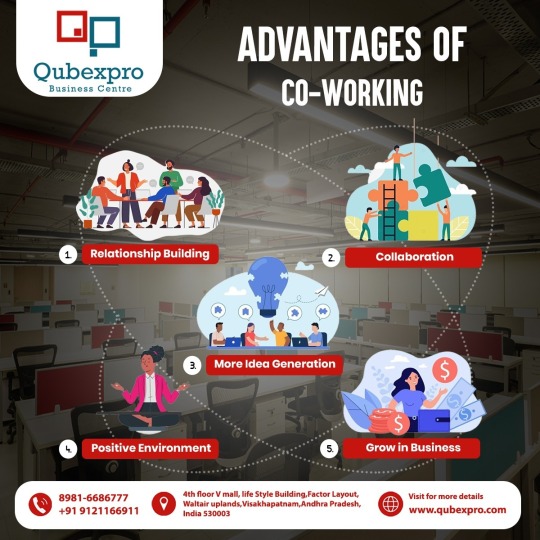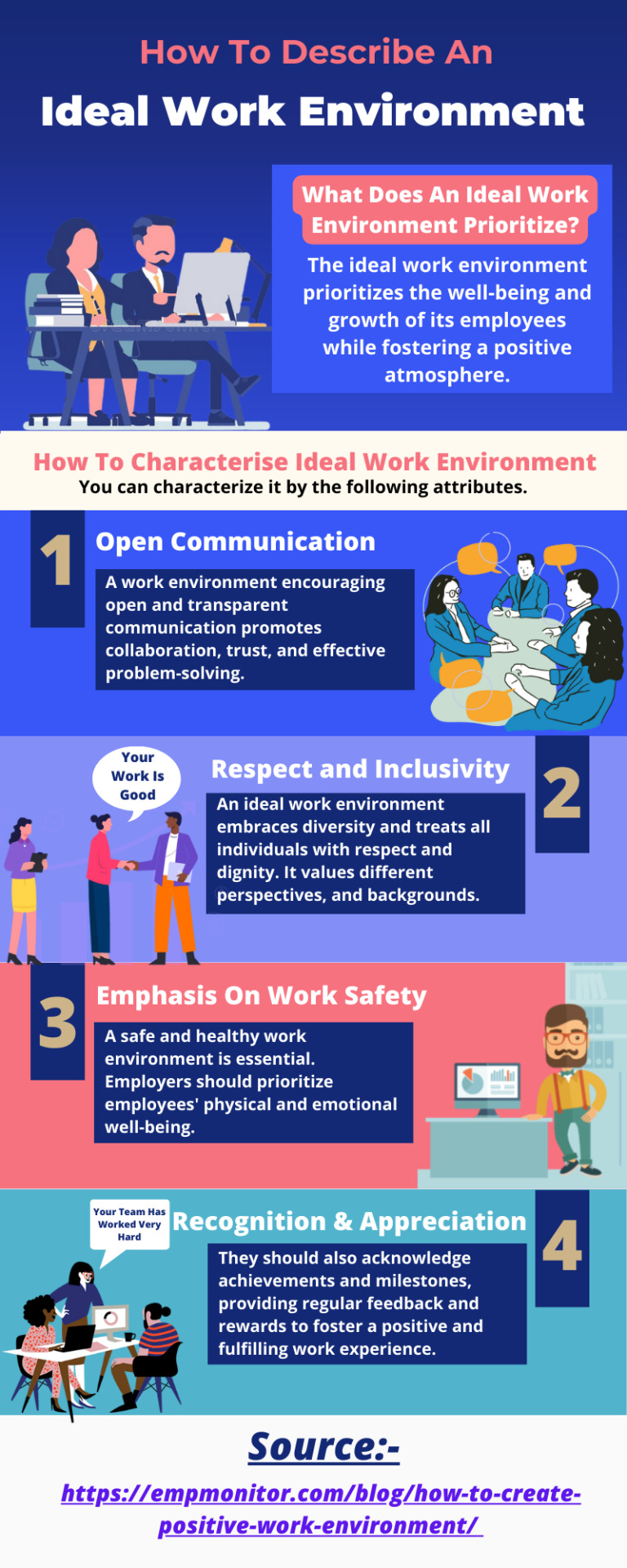#positiveworkenvironment
Explore tagged Tumblr posts
Text

The secret to being happy at work? It’s simpler than you think!
Happiness at work isn’t about perks or free snacks—it’s about creating an environment where you feel valued, motivated, and inspired.
Here’s what really makes the difference:
1. Doing work that excites you
2. Having a supportive, fun team
3. Enjoying a balanced work-life routine
4. Getting recognition for your hard work
5. Growing through learning opportunities
6. Feeling heard and valued
7. Clear goals to keep you focused
8. Flexibility that fits your life
9. Autonomy to own your projects
10. A culture that values wellbeing
Work with us and you’ll enjoy Mondays too!
https://bizessence.com.au/jobs/
#bizessence#happinessatwork#worklifebalance#employeewellbeing#teamwork#motivation#workplaceculture#jobsatisfaction#careergrowth#positiveworkenvironment#mondaymotivation
0 notes
Text
🚀 How Team Members Can Contribute to Project Success: Part 1 🚀
Unlock the secrets to stellar project performance! Dive into our guide to see how mastering communication and collaboration can set your team up for success. 🌟
#TeamSuccess#ProjectManagement#Communication#Collaboration#ITProjects#MagnusMinds#TejasShah#ProjectSuccess#QualityCommitment#TimeManagement#ProactiveSolutions#PositiveWorkEnvironment#Teamwork#ITLeadership#ContinuousImprovement#EffectiveCollaboration#TeamCollaboration#EffectiveCommunication#Leadership#TeamDynamics
0 notes
Text

🌟 Discover the Benefits of Co-Working at Qubexpro Business Centre! 🌟
Are you ready to transform your work experience? Join us at Qubexpro and unlock the incredible advantages of co-working!
1️⃣ Relationship Building: Network and build valuable connections with like-minded professionals. 2️⃣ Collaboration: Work together, share ideas, and create amazing projects as a team. 3️⃣ More Idea Generation: Fuel your creativity and innovation in a dynamic work environment. 4️⃣ Positive Environment: Enjoy a vibrant and positive workspace that boosts productivity. 5️⃣ Grow in Business: Leverage the supportive community to grow and scale your business.
📍 Visit us at 4th floor V mall, Lifestyle Building, Factor Layout, Waltair Uplands, Visakhapatnam, Andhra Pradesh, India 530003.
📞 Contact us at 8981-668677 or +91 9121166911 for more details.
🌐 Learn more at www.qubexpro.com
#CoWorking#BusinessGrowth#Networking#Collaboration#Qubexpro#Visakhapatnam#PositiveWorkEnvironment#Innovation#Entrepreneurship
0 notes
Text
"Spirituality in the Workplace: Fostering a Supportive Environment for Employee Well-being"

Hook:
In recent years, there has been a growing recognition of the importance of spirituality in the workplace. While traditionally, the workplace has been viewed primarily as a space for productivity and economic exchange, there is a growing understanding that it also plays a significant role in shaping the overall well-being of employees. This shift in perspective has led to a re-evaluation of organizational practices and policies, with many businesses now actively seeking to foster a supportive environment that nurtures the spiritual dimension of their employees' lives. In this essay, we will explore the concept of spirituality in the workplace and its implications for employee well-being, examining how organizations can create an environment that honours and supports the spiritual needs of their workforce.
Defining Spirituality in the Workplace:
Before delving into the ways in which spirituality can be integrated into the workplace, it is essential to clarify what we mean by spirituality in this context. While spirituality is often associated with religious beliefs and practices, it encompasses a broader range of experiences and perspectives. At its core, spirituality is about connecting to something greater than oneself, whether that be through a sense of purpose, meaning, or transcendence. In the workplace, spirituality can manifest in various forms, including a sense of community, purpose-driven work, and ethical decision-making. It is about fostering an environment where employees feel valued, supported, and empowered to bring their whole selves to work.
Recognizing the Importance of Employee Well-being:
Employee well-being is increasingly recognized as a critical factor in organizational success. Happy, healthy employees are more engaged, productive, and committed to their work. Moreover, organizations that prioritize employee well-being tend to have lower turnover rates and higher levels of employee satisfaction. However, traditional approaches to promoting well-being often focus solely on physical and mental health, overlooking the spiritual dimension of human experience. By acknowledging and addressing the spiritual needs of employees, organizations can create a more holistic approach to well-being that benefits both individuals and the organization as a whole.
Creating a Supportive Environment for Spiritual Well-being:
There are several strategies that organizations can employ to foster a supportive environment for spiritual well-being in the workplace:
Cultivating a Sense of Purpose: Employees are more engaged and motivated when they feel connected to a larger purpose beyond just making a profit. Organizations can foster a sense of purpose by articulating a clear mission and values that resonate with employees' personal beliefs and aspirations. Providing opportunities for employees to contribute to meaningful projects and initiatives can also help reinforce their sense of purpose and fulfillment.
Encouraging Authenticity and Vulnerability: Authenticity is essential for spiritual well-being, as it involves being true to oneself and honouring one's values and beliefs. Organizations can create a culture of authenticity by encouraging open communication, transparency, and vulnerability. Leaders play a crucial role in modelling authentic behaviour and creating a safe space where employees feel comfortable expressing their true selves without fear of judgment or reprisal.
Supporting Work-Life Integration: Achieving a balance between work and personal life is essential for spiritual well-being. Organizations can support work-life integration by offering flexible work arrangements, such as telecommuting or flexible hours, that allow employees to better manage their personal and professional responsibilities. Additionally, promoting boundaries and encouraging employees to prioritize self-care can help prevent burnout and promote overall well-being.
Fostering a Sense of Community: Humans are social beings, and a sense of belonging is fundamental to spiritual well-being. Organizations can foster a sense of community by creating opportunities for employees to connect with one another on a personal level. This can include team-building activities, social events, or volunteer opportunities that bring employees together around shared interests or values. Building strong relationships and networks within the workplace not only enhances spiritual well-being but also promotes collaboration and teamwork.
Providing Support for Personal Growth and Development: Personal growth and development are integral to spiritual well-being, as they involve continuous learning and self-improvement. Organizations can support employees' growth and development by providing access to training and development programs, mentoring opportunities, and resources for personal enrichment. By investing in their employees' growth and development, organizations not only enhance individual well-being but also build a more skilled and resilient workforce.
Food For Thought:
In conclusion, spirituality in the workplace is about creating a supportive environment that honours and nurtures the spiritual dimension of employees' lives. By recognizing the importance of spirituality in promoting well-being, organizations can create a more holistic approach to employee wellness that benefits both individuals and the organization as a whole. By cultivating a sense of purpose, encouraging authenticity and vulnerability, supporting work-life integration, fostering a sense of community, and providing support for personal growth and development, organizations can create a workplace where employees feel valued, supported, and empowered to thrive. In doing so, they can unlock the full potential of their workforce and create a culture of flourishing and fulfillment.
#WorkplaceSpirituality#EmployeeWellbeing#HolisticWellness#PurposefulWork#AuthenticCulture#CommunityBuilding#WorkLifeIntegration#PersonalGrowth#ProfessionalDevelopment#TeamCollaboration#EmployeeEngagement#CorporateCulture#SpiritualWellness#WellnessAtWork#PositiveWorkEnvironment
0 notes
Text
Toxic Employees
Photo by Nadine Shaabana Toxic employees can be as bad if not worse than a bad manager or even inept leadership. Toxic employees are typically overconfident and selfish and generally understand how to walk the fine line between right and wrong to ensure they do not fall foul of company policy. They generally do not cooperate with others or respect their peers because they’re always looking out…

View On WordPress
#AddressingToxicity#BuildingHealthyTeams#ConflictResolution#CorporateWellbeing#DealingWithToxicity#EmployeeMoraleBoost#EmployeeRelations#HealthyWorkplaceTips#ManagingToxicity#NegativeWorkplaceBehavior#PositiveWorkEnvironment#TeamCollaboration#TeamDynamics#ToxicColleagues#ToxicEmployees#ToxicityAwareness#ToxicWorkplaceCulture#WorkplacePositivity#WorkplaceToxicity#WorkplaceWellness
0 notes
Text
From "Meh" to Explosive! Secrets of Feedback that Doesn't Sting
#growthmindset#productivity#employeedevelopment#performancemanagement#communicationskills#feedback#motivation#teambuilding#positiveworkenvironment#personalgrowth#companyculture
0 notes
Text

Want to make a healthier and positive work environment?
Good health = good business.
Happy employees also = good business.
The working environment plays a huge role in health and well-being.
0 notes
Text
How Servant Leadership Inspires Teams and Fosters Success?

Leaders and organizations foster meaningful connections, promote teamwork, and drive positive change. By adopting servant leadership principles and practicing active listening, empathy, and empowerment, leaders can create environments where individuals are valued, supported, and empowered to reach their full potential.
As we embrace the digital age and its unique challenges, this leadership type proves to be adaptable and enduring, providing a roadmap for leaders to thrive in the ever-evolving landscape of work and relationships. The true essence of this type of leadership lies in the belief that by lifting others up, we can collectively reach greater heights and build a brighter future.
In a world where leadership styles vary, servant leadership stands out as an approach that prioritizes the well-being and development of team members. By focusing on service, empathy, and empowerment, servant leaders aim to create a positive work environment and foster personal and professional growth.
In this blog, we will delve into the concept of servant leadership, its core principles, benefits, and practical strategies for implementing this approach within your organization.
What Is Servant Leadership?
https://enterprisewired.com/wp-content/uploads/2023/11/2.1-What-Is-Servant-Leadership.jpg
It is a leadership philosophy that places the leader in a service-oriented role, emphasizing the needs and development of their team members above all else. It was introduced by Robert K. Greenleaf in the 1970s and has since gained recognition as a powerful and effective leadership style.
Key Principles:
Service: The primary role of a servant leader is to serve the needs of their team members, assisting them in reaching their goals and full potential.
Empathy: Servant leaders exhibit a deep understanding of and care for the well-being of their team members, seeking to build strong interpersonal relationships.
Empowerment: Servant leaders empower their team, providing guidance and resources to help them succeed while allowing them autonomy in decision-making.
Listening: Listening is a cornerstone of this type of leadership, as it allows leaders to understand their team’s perspectives, needs, and concerns.
The Benefits of Servant Leadership
It offers a range of advantages for both leaders and their teams, including:
Enhanced Team Morale: Servant leaders create a positive work environment, leading to higher team morale and job satisfaction.
Improved Collaboration: The emphasis on empathy and relationships fosters stronger collaboration and trust among team members.
Increased Productivity: Empowering team members to make decisions and take ownership of their work often leads to increased productivity.
Personal Growth: Team members under servant leaders have opportunities for personal and professional growth, as leaders support their development.
Stronger Employee Retention: Employees are more likely to stay with organizations that practice servant leadership due to their positive work experience.
Practical Strategies for Implementation
Implementing this leadership involves a shift in perspective and the adoption of specific practices:
Lead by Example: Demonstrate the behaviors and values you want your team to embody, showing your commitment.
Active Listening: Develop active listening skills, showing genuine interest in your team members’ ideas and concerns.
Empower and Delegate: Provide team members with opportunities to take ownership of projects and decisions, trusting their abilities.
Support Growth: Offer mentoring, coaching, and resources to help team members achieve their personal and professional goals.
Create a Positive Work Environment: Foster a workplace culture that emphasizes respect, collaboration, and a sense of purpose.
Real-World Examples of Servant Leadership
https://enterprisewired.com/wp-content/uploads/2023/11/2.2-Real-World-Examples-of-Servant-Leadership-credit-getty-images.jpg
Several leaders throughout history and in contemporary times have embodied the principles of this type of leadership. Mahatma Gandhi, Nelson Mandela, and Mother Teresa are renowned examples of servant leaders who have made significant positive impacts on society.
In the business world, organizations like The Container Store and Southwest Airlines are known for practicing this leadership. These companies place their employees at the forefront, recognizing that when employees are taken care of, they, in turn, take care of the customers.
Relevance in the Digital Age
Servant leadership remains relevant in the digital age, with leaders adapting the philosophy to remote work and virtual team environments. Digital tools and technologies have made it possible for servant leaders to maintain strong relationships and communication with team members, despite physical distances.
Overcoming Challenges
While servant leadership is a powerful approach, it is not without challenges. Leaders may face resistance from team members accustomed to more traditional leadership styles. Additionally, finding a balance between serving team members and making tough decisions for the greater good of the organization can be a delicate challenge. Servant leaders must navigate these challenges with empathy and transparency.
Measuring Success
https://enterprisewired.com/wp-content/uploads/2023/11/2.3-Measuring-Success.jpg
Measuring the success in this leadership involves looking at both team and organizational outcomes. Metrics may include employee satisfaction surveys, retention rates, productivity, and the level of collaboration among team members. Success in this leadership is reflected in the overall well-being and growth of team members and the positive impact on the organization.
Conclusion
Servant leadership is a powerful and transformative leadership style that emphasizes service, empathy, and empowerment. By focusing on the needs and development of team members, servant leaders create a positive work environment that fosters personal and professional growth, collaboration, and high morale. This approach has been successfully applied in various contexts, from world-changing movements to progressive organizations.
As we navigate the challenges of the modern world, servant leadership remains a beacon of hope, reminding us that leadership is not about wielding authority but about serving others and bringing out the best in those we lead. It is a timeless philosophy that continues to inspire teams to achieve success.
Also Read: Are These 5 Toxic Workplace Behaviors Driving Away Your Talent?
#ServantLeadership#LeadershipStyle#SuccessInspiration#TeamEmpowerment#PositiveWorkEnvironment#LeadershipPrinciples#TeamCollaboration#PersonalGrowth
0 notes
Text
"Driving Business Success: The Power of Strong Leadership Unveiled"
Why is strong leadership important for business success? What are the qualities of an effective leader? How does leadership style affect organizational success? Why is leadership development important in an organization? What role do leaders play in fostering a positive work environment? Q: Why is strong leadership crucial for driving business success? Q: How does strong leadership impact employee performance? Q: What qualities and skills are important for strong leadership? Q: How can strong leadership drive innovation within a business? Q: Can strong leadership impact the overall company culture? Q: How can leaders adapt their leadership style to different situations? Q: How can organizations develop strong leaders? Welcome to our article on the crucial role of strong leadership in driving business success. In today's highly competitive business landscape, having effective leaders is more important than ever. Strong leaders can create a positive work environment, foster employee engagement, and develop strong leadership skills in team members. In this article, we will explore why strong leadership is important for business success, the qualities of an effective leader, how leadership style affects organizational success, the importance of leadership development, and the role leaders play in fostering a positive work environment.
Why is strong leadership important for business success?
Creating a positive work environment Strong leaders play a critical role in creating a positive work environment. They set the tone for the entire organization by exemplifying professionalism, respect, and integrity. By fostering a positive work environment, leaders inspire their team members to feel motivated, valued, and engaged. This, in turn, leads to higher levels of productivity and a more enjoyable workplace. Fostering employee engagement Employee engagement is essential for the success of any business. When employees are engaged, they are more likely to work towards achieving the company's goals and objectives. Strong leaders foster employee engagement by creating a culture of trust, open communication, and collaboration. They encourage their team members to take ownership of their work and provide them with opportunities for professional growth and development. Developing strong leadership skills in team members Effective leaders understand the importance of developing strong leadership skills in their team members. They provide mentorship, guidance, and support to help their team members grow both personally and professionally. By investing in the development of their team members, leaders not only enhance the overall performance of the organization but also build a strong pipeline of future leaders. "The function of leadership is to produce more leaders, not more followers." - Ralph Nader


What are the qualities of an effective leader?
Charismatic leadership Charismatic leaders have a magnetic personality that inspires and motivates others. They can create a vision that others can rally behind and believe in. Charismatic leaders are excellent communicators, confident decision-makers, and have a strong presence that commands respect. Servant leadership Servant leaders prioritize the needs of their team members over their own. They lead by example and are focused on serving the needs of their team and the organization. Servant leaders empower their team members, provide them with the necessary resources and support, and encourage them to reach their full potential. Creating a culture of innovation Effective leaders understand the importance of creating a culture of innovation within their organizations. They encourage their team members to think creatively, take risks, and embrace failure as a learning opportunity. By fostering a culture of innovation, leaders enable their organizations to stay ahead of the competition and adapt to changing market demands. "Success is not final, failure is not fatal: It is the courage to continue that counts." - Winston Churchill

How does leadership style affect organizational success?
Creating a sense of purpose and direction Leadership style plays a crucial role in creating a sense of purpose and direction within an organization. Effective leaders have a sharp vision and can communicate it to their team members in a way that inspires and motivates them. They provide a clear roadmap for success and help their team members understand how their individual roles contribute to the overall success of the organization. Empowering team members and giving autonomy Leaders who empower their team members and give them the autonomy to make decisions are more likely to achieve organizational success. By trusting their team members, leaders not only foster a sense of ownership and accountability but also unleash the full potential of their employees. Empowered team members are more motivated, innovative, and willing to go the extra mile to achieve the organization's goals. Promoting productivity and generating innovative ideas Leadership style has a direct impact on the productivity and creativity of the organization. Effective leaders create an environment that encourages collaboration, teamwork, and the exchange of ideas. They provide the necessary resources and support to ensure that their team members have everything they need to succeed. By promoting productivity and generating innovative ideas, leaders drive innovation and help the organization stay ahead in the market. "The only way to do great work is to love what you do." - Steve Jobs


Why is leadership development important in an organization?
Building a strong pipeline of future leaders Leadership development is essential for building a strong pipeline of future leaders. Effective leaders invest in the development of their team members by providing them with opportunities for growth, mentorship, and training. By developing the leadership skills of their team members, leaders ensure a smooth transition of leadership roles and empower their employees to take on new challenges. Enhancing overall organizational performance Leadership development has a direct impact on the overall performance of the organization. When leaders are equipped with the necessary skills, knowledge, and abilities, they are better able to make informed decisions, motivate their team members, and drive organizational success. Effective leaders inspire their team members to perform at their best and create an environment that fosters high performance. Ensuring long-term success and continuity Leadership development is crucial for ensuring the long-term success and continuity of an organization. Effective leaders groom their successors and prepare them to take on leadership roles in the future. By developing a pipeline of future leaders, organizations can navigate through challenges, adapt to changes, and continue to thrive in a dynamic business environment. "Leadership and learning are indispensable to each other." — John F. Kennedy

Top 10 Startup Mistakes and How to Avoid Them

What role do leaders play in fostering a positive work environment?
Creating an environment of trust and collaboration Leaders play a crucial role in creating an environment of trust and collaboration. They lead by example and build trust with their team members through open and honest communication. Effective leaders encourage collaboration, teamwork, and the sharing of ideas. They create a safe space where team members feel comfortable expressing their opinions, taking risks, and challenging the status quo. Supporting work-life balance and employee well-being Leaders who prioritize work-life balance and employee well-being contribute to a positive work environment. They understand that employees who are well-rested, healthy, and happy are more productive and engaged. Effective leaders support and encourage their team members to maintain a healthy work-life balance, take time off to recharge, and prioritize their well-being. Encouraging a culture of open communication and feedback Leaders who encourage a culture of open communication and feedback create an environment where team members feel heard and valued. They actively seek input and feedback from their team members, encourage constructive dialogue, and are open to innovative ideas and perspectives. Effective leaders provide regular feedback and recognition to their team members, fostering a culture of continuous improvement and growth "Leadership is not about being in charge. It is about taking care of those in your charge." — Simon Sinek


Q: Why is strong leadership crucial for driving business success?
A: Strong leadership is crucial for driving business success because it sets the vision, direction, and goals for the organization. Effective leaders inspire and motivate employees, foster a positive work culture, make strategic decisions, and ensure efficient execution of plans. They also provide guidance, support, and mentorship to employees, which leads to increased productivity, innovation, and overall business growth.
Q: How does strong leadership impact employee performance?
A: Strong leadership has a significant impact on employee performance. When leaders effectively communicate expectations, provide clear guidance, and offer support and recognition, employees feel motivated and engaged. Strong leaders also create a positive work environment that encourages collaboration, creativity, and continuous improvement. This, in turn, boosts employee morale, productivity, and leads to improved business outcomes.
Q: What qualities and skills are important for strong leadership?
A: Several qualities and skills are important for strong leadership. These include excellent communication and interpersonal skills, the ability to inspire and motivate others, the capacity to make tough decisions, adaptability, strategic thinking, and emotional intelligence. Strong leaders are also good at building relationships, fostering teamwork, and empowering their employees to reach their full potential.
Q: How can strong leadership drive innovation within a business?
A: Strong leadership plays a crucial role in driving innovation within a business. Leaders who encourage creativity, embrace innovative ideas, and foster a culture of innovation create an environment where employees feel empowered to take risks and be creative. By setting a sharp vision and providing resources and support, strong leaders can inspire and motivate employees to produce innovative solutions, products, and services that give the business a competitive edge.
Q: Can strong leadership impact the overall company culture?
A: Yes, strong leadership has a significant impact on the overall company culture. Leaders set the tone for the organization and their behavior and actions shape the values, norms, and behaviors of employees. A strong leader who promotes transparency, trust, and open communication can create a positive and inclusive work culture. On the other hand, a weak or ineffective leader can contribute to a toxic work environment, low morale, and high employee turnover.
Q: How can leaders adapt their leadership style to different situations?
A: Effective leaders understand the importance of adapting their leadership style to different situations. They recognize that different circumstances and individuals require different approaches. For example, in times of crisis, a leader may need to be more directive and authoritative. In other situations, a more collaborative and democratic leadership style may be appropriate. Adapting leadership style involves being flexible, understanding the needs of the team and organization, and being willing to adjust approaches accordingly.
Q: How can organizations develop strong leaders?
A: Organizations can develop strong leaders through various means. These include providing leadership training and development programs, mentoring and coaching opportunities, rotational assignments, and regular feedback and performance evaluations. Encouraging employees to take on leadership roles and providing them with opportunities to lead projects or teams can also help in developing strong leaders. Additionally, organizations can create a culture that values and supports leadership development through recognition and promotion of individuals who demonstrate strong leadership skills. Read the full article
#BusinessSuccess#collaboration#Communication#conflictresolution#continuousimprovement#effectiveleaders#emotionalintelligence#employeeengagement#empowerment#leadership#leadershipdevelopment#mentorship#positiveworkenvironment#professionalgrowth.#recognition#teamwork#well-being#work-lifebalance#workplaceculture
0 notes
Text
Finding Joy in Work: The Path to Success and Fulfillment
Through this blog, we will explore the power of enjoyment in the workplace and how it can lead to success and creativity in our professional lives. I'll be sharing insights on recognizing signs of job dissatisfaction, and the courage it takes to explore
Introduction:Work occupies a significant portion of our lives, and its impact on our overall well-being cannot be underestimated. Many of us spend a substantial amount of time engaged in our professions, but how often do we stop and ponder whether we are truly enjoying what we do? As the saying goes, “People rarely succeed unless they have fun in what they are doing.” In this blog, we will…
View On WordPress
#CareerFulfillment#CareerPathExploration#FindingJoyInWork#JobSatisfaction#PassionAndSuccess#PositiveWorkEnvironment#ProfessionalGrowth#PursuingPassion#WorkPlaceHappiness
1 note
·
View note
Text
Beyond Complaints | Building and Communicating an Effective HR System | Lanteria HR

👥 In today's dynamic business landscape, a strong and effective HR system is vital for fostering a positive and productive work environment. Join us as we go beyond mere complaints and explore the essential elements of building and communicating an impactful HR system. From fostering employee engagement to promoting a culture of trust and transparency, this journey will provide valuable insights into optimizing your HR practices. Let's empower your organization and elevate your HR strategy with Lanteria HR. 💼
#EffectiveHRSystem#EmployeeEngagement#PositiveWorkEnvironment#HRBestPractices#CommunicationStrategy#CultivatingCulture#TrustAndTransparency#HRInnovation#LanteriaHR#WorkplaceEmpowerment
0 notes
Text

In this infographics, we will learn how to describe an ideal work environment
#workenvironment#employeeworkplace#positiveworkenvironment#badworkenvironment#howtocreateapositiveworkenvironment
0 notes
Text
Cultivating Compassion: How Spiritual Practices Foster a Positive Work Environment

Hook:
In the bustling corridors of today's workplaces, cultivating compassion has emerged as a transformative approach to fostering a positive and thriving work environment. Rooted in spiritual practices and principles, compassion transcends mere empathy, extending towards understanding, kindness, and action. In this article, we delve into the profound connection between spirituality and compassion, exploring how integrating spiritual practices into the workplace can nurture a culture of empathy, collaboration, and well-being.
Understanding Compassion:
Compassion is more than just a fleeting emotion; it is a fundamental aspect of human connection and understanding. At its core, compassion involves recognizing and alleviating the suffering of others, whether it be physical, emotional, or spiritual. By cultivating compassion, individuals cultivate a deeper sense of empathy, kindness, and altruism, fostering positive relationships and contributing to a more compassionate world.
The Role of Spiritual Practices:
Spiritual practices offer a rich tapestry of tools and techniques for cultivating compassion in the workplace. Whether it's mindfulness meditation, loving-kindness meditation, or reflective journaling, these practices provide pathways to deepen one's capacity for compassion and empathy. By integrating spiritual practices into the fabric of organizational culture, leaders can create environments where compassion becomes a guiding principle in decision-making, communication, and collaboration.
Creating a Compassionate Work Environment:
Mindfulness: Mindfulness serves as the foundation for cultivating compassion, as it allows individuals to cultivate awareness and presence in the present moment. By practicing mindfulness techniques such as meditation, deep breathing, or mindful walking, employees can develop greater empathy and compassion towards themselves and others.
Loving-Kindness Meditation: Loving-kindness meditation is a powerful practice for cultivating compassion and empathy towards oneself and others. By silently repeating phrases of loving-kindness, such as "May I be happy, may I be healthy, may I be safe, may I be at peace," individuals can cultivate feelings of warmth, kindness, and compassion towards themselves and extend these sentiments to others.
Active Listening: Active listening is a key component of compassionate communication, as it involves fully engaging with others and seeking to understand their perspectives and experiences. By practicing active listening techniques such as maintaining eye contact, paraphrasing, and asking clarifying questions, employees can foster deeper connections and empathy in their interactions.
Empathy Training: Empathy training programs can help employees develop their capacity for empathy and compassion by providing education, skills training, and experiential learning opportunities. By learning to recognize and validate the emotions and experiences of others, employees can foster a culture of empathy and understanding in the workplace.
Acts of Kindness: Encouraging acts of kindness and generosity can help foster a culture of compassion in the workplace. Whether it's volunteering together, organizing charity drives, or simply expressing gratitude and appreciation, these acts of kindness create ripple effects of positivity and connection throughout the organization.
Benefits of a Compassionate Work Environment:
A compassionate work environment offers a host of benefits for both individuals and organizations. From increased employee satisfaction and well-being to improved teamwork and collaboration, compassion fosters a sense of belonging, purpose, and fulfillment in the workplace. By cultivating compassion, organizations can enhance employee engagement, retention, and productivity, creating a positive and thriving work culture that attracts top talent and fosters long-term success.
Food For Thought:
In today's fast-paced and often stressful work environments, cultivating compassion is more important than ever. By integrating spiritual practices such as mindfulness, loving-kindness meditation, and active listening into the workplace, leaders can create environments where compassion becomes a guiding principle in decision-making, communication, and collaboration. Through acts of kindness, empathy training, and fostering a culture of compassion, organizations can create workplaces where individuals thrive, teams flourish, and well-being is prioritized alongside performance. As we embrace the transformative power of compassion, let us remember that small acts of kindness and empathy can create ripple effects of positivity and connection that extend far beyond the walls of the workplace, fostering a more compassionate world for all.
#CompassionateWorkplace#SpiritualPractices#EmpathyAtWork#PositiveWorkEnvironment#MindfulLeadership#KindnessCulture#CollaborativeTeams#WellnessInBusiness#EmployeeEngagement#ProductivityBoost#WorkplaceCulture#EmpatheticLeadership#SpiritualWellbeing#TeamHarmony#PositiveVibesAtWork
0 notes
Photo

🚨𝙏𝙤 𝙄𝙢𝙥𝙧𝙤𝙫𝙚 𝙩𝙝𝙚 𝘾𝙪𝙨𝙩𝙤𝙢𝙚𝙧 𝙀𝙭𝙥𝙚𝙧𝙞𝙚𝙣𝙘𝙚, 𝙄𝙢𝙥𝙧𝙤𝙫𝙚👏 𝙩𝙝𝙚 👏 𝙀𝙢𝙥𝙡𝙤𝙮𝙚𝙚👏 𝙀𝙭𝙥𝙚𝙧𝙞𝙚𝙣𝙘𝙚👏 This might sound basic, but it's something business owners need to keep in mind. It's downright impossible for an unhappy employee to project joy and a warm welcome to clients.💯 Have you ever used a service and felt that the representative that attended to you wasn't happy with their job? How would you describe your experience with that particular company?😏 I'm sure you have some choice words for them.👌 And that's the same thing that happens when our customers converse with reps who have checked out of their jobs before they even clocked in.🎯 Inasmuch as we discuss the importance of creating a great customer experience for your clients, a good employee experience also goes a long way. Happy employees make for happy customers who keep your business afloat.💯🎯
0 notes
Text
Unlock Your Team’s Hidden Potential: The Art of Empowering Feedback (That Doesn’t Sting)
#leadership#teamwork#employeedevelopment#performancemanagement#communicationskills#feedback#motivation#teambuilding#positiveworkenvironment#personalgrowth#companyculture
0 notes
Text
🌟 Elevate Your Organization's Emotional Healthcare Journey with Manah Wellness! 🌟 Discover the ultimate partner in fostering emotional wellbeing within your workplace – Manah Wellness. With a deep understanding of both employee needs and organizational goals, we're here to make a real difference in your employees' lives while aligning with your vision. 🌱 Transformative Solutions: Experience a new era of emotional wellbeing through our innovative approach and transformative solutions. We're dedicated to helping your teams thrive by creating a culture that prioritizes mental health. 🤝 A Caring Team: Feel the difference with a team that genuinely cares about your employees' wellbeing. We're passionate about delivering solutions-oriented emotional healthcare services to create a healthier, happier workplace environment. 💡 Comprehensive Wellbeing: Benefit from our 360-degree approach to wellbeing. Our team of professionals offers comprehensive care that addresses every aspect of your employees' emotional health and wellbeing. 🤲 Lasting Impact: Partner with us for a journey towards lasting impact. We're committed to collaborating with organizations that share our long-term perspective on employee wellbeing, striving to create a positive and sustainable difference. Join hands with Manah Wellness and embark on a journey to transform your workplace and the lives of your employees! 🌟
#hashtag#MentalHealthSolutions hashtag#EmployeeWellbeing hashtag#WellnessCulture hashtag#EmotionalHealthcare hashtag#WorkplaceWellness hashtag#ComprehensiveCare hashtag#LongTermImpact hashtag#PositiveWorkEnvironment hashtag#SustainableWellbeing hashtag#InnovativeWellness
0 notes